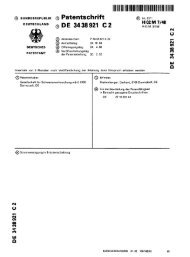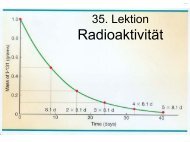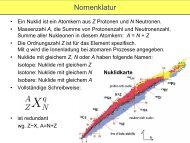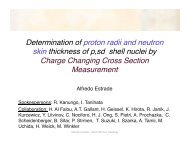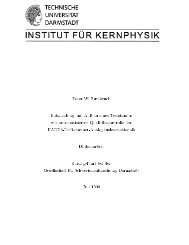doctoral thesis
doctoral thesis
doctoral thesis
Create successful ePaper yourself
Turn your PDF publications into a flip-book with our unique Google optimized e-Paper software.
20 CHAPTER 1. INTRODUCTION<br />
in which the particle tracks were photographed. Nevertheless, the technology of particle<br />
detectors has with time evolved from these optical methods to electrical methods.<br />
Scintillation counters coupled to photo-multipliers are a successful example. Starting<br />
in the late nineteen-sixties high voltage operated gaseous detectors such as wire or<br />
drift chambers [12] have successfully replaced the scintillation counter in experiments<br />
requiring a high spatial resolution. Conversely the scintillator is still a very commonly<br />
utilized technique to obtain high time resolution in current apparatus for sub nuclear<br />
research.<br />
1.3.1 Time Resolution<br />
The wire based gaseous detectors are indeed not competitive with the scintillator as<br />
far as time resolution is concerned. The reason lies in the fact that the distance of the<br />
closest primary cluster to the wire is exponentially distributed. Due to the 1/r field the<br />
amplification is limited to the region around the wire and all electrons need to drift into<br />
this region before amplification and the signal generation set in. This introduces a time<br />
jitter and limits the time resolution of wire based detectors to a few nanoseconds. A<br />
better time resolution is achievable if a strong uniform electric field is used instead of<br />
that of a charged wire. Here the avalanche amplification sets in instantly for all primary<br />
clusters. The intrinsic detector time resolution is then dominated by the avalanche<br />
statistics.<br />
1.3.2 Spark Counter<br />
The first gas detector taking advantage of the improved time resolution in strong uniform<br />
electric fields was the Keuffel Spark Counter, a gaseous avalanche detector with<br />
parallel plate geometry, that was introduced in 1948 [26, 27]. It indeed offered a time<br />
resolution (around 1 ns) by far better than any of the Geiger-Müller Counters that were<br />
commonly used at that time (around 100 ns) [28]. This development opened the possibility<br />
for the construction of accurate timing systems to measure the velocity of fast<br />
charged particles.<br />
Spark Counters generally consist of two planar metal electrodes with a high voltage<br />
applied to them. The gap between the plates is filled with a gas. The passage of a<br />
charged particle leaves an trail of free charge carriers (primary ionization) in the gas<br />
which triggers avalanches of charge carriers in the electric field. At a certain size of<br />
the avalanches they transform into a streamer. A streamer is defined as a state where<br />
photons contribute to the spread of free charge carriers. At a later stage a conducting<br />
plasma filament connecting the two electrodes is formed. Through this channel the<br />
electrodes are discharged; a spark is created. The rapidly growing anode current is<br />
transformed by a resistor into a fast voltage signal and this signal can be taken as a







